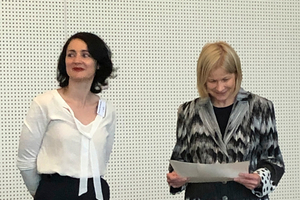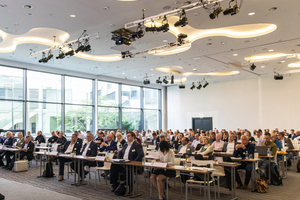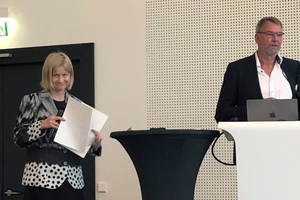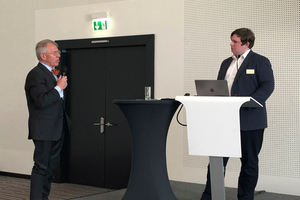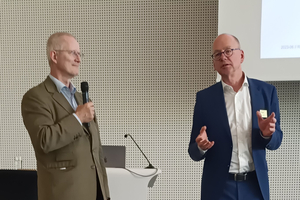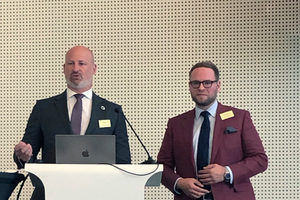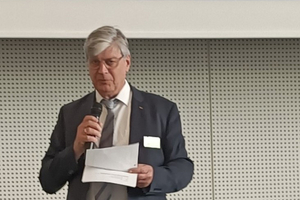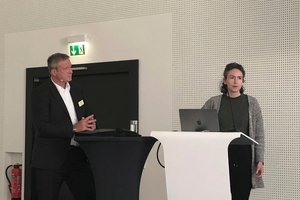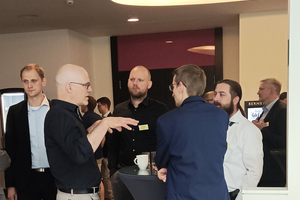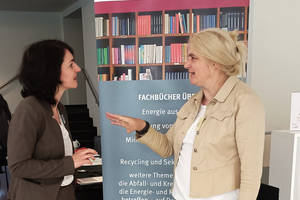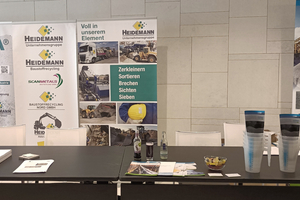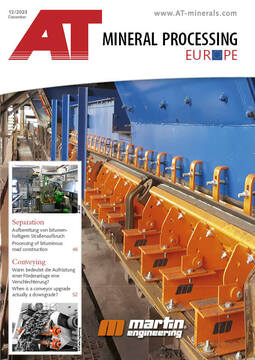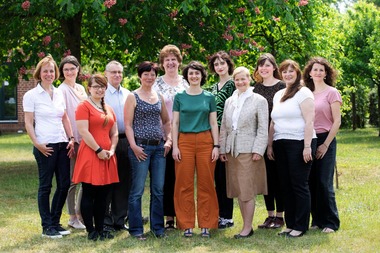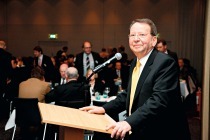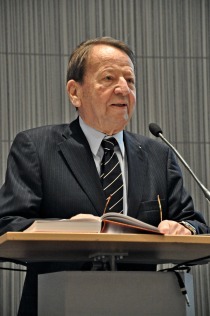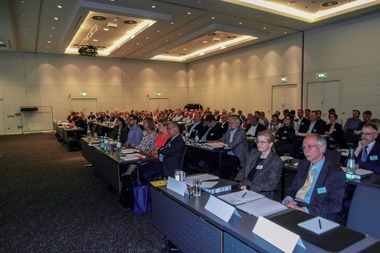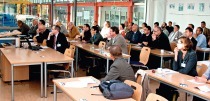BKMNA`23 – Berlin Conference “Mineral By-Products and Waste” 2023
By the members of the program committee em. Univ. Prof. Dr.-Ing. Dr. h.c. Dieter Georg Senk as well as Prof. Dr.-Ing. Herrmann Wotruba (†) (both RWTH Aachen), Univ. Prof. Dr. mont. Helmut Antrekovitsch as well as Univ. Prof. Dr. mont. Roland Pomberger (both Montanuniversität Leoben), an interesting and varied scientific program was presented and experts from the industry were invited as speakers.
The event was opened by the managing director of Thomé-Kozmiensky Verlag GmbH, Elisabeth Thomé-Kozmiensky, who referred to the redesign of the website and the digital orientation, including the publication of the technical book about the conference as an e-book. Stephanie Thiel, who was responsible for the program coordination and also moderated the first two lectures, gave an introduction to the topic of the conference. The conference focused on the material flow shifts that are occurring for the industry as a result of the measures taken to combat climate change and their consequences for the by-products of the iron and steel industry, which are so important for the construction industry.
The first day of the conference was dedicated to recycled building materials from scientific, practical, legal, but also political points of view. Dr. Ing. Berthold Schäfer, Managing Director of the Bundesverband Baustoffe – Steine und Erden e.V. (Federal Association of Building Materials – Stones and Soil), Berlin, made a plea for an infinite recycling economy (Closed Loop = CL), for which approx. 65 % of granular building material waste is suitable, and dealt with the industry-specific voluntary commitment of the building product manufacturers to CL. This is a unilateral and non-binding voluntary commitment by the industry to politicians. The current status was explained (the bitumen and gypsum industries are already successfully implementing CL, but increasingly there is competition for use due to material flow shifts). On the basis of the status quo, Dr. Schäfer concluded that the voluntary commitment would be advantageous for both industry and politics, since, among other things, both pursue the same goals (CO2 reduction), implementation would be much faster than with legislation, and investment security would be promoted. He suggested a gradual further development of the voluntary commitments, starting with the commitment between recycling plant operators and cement manufacturers or concrete producers on a regional basis and then on a supraregional basis.
Provocative but realistic was the title of the presentation by Dipl.-Ing. Frank Hlawatsch, head of the MPA of the Free Hanseatic City of Bremen: “Use of recycled aggregates for the production of construction products - researched but not implemented. He presented research results from the Forschungsvereinigung Recycling und Wertstoffverwertung im Bauwesen e. V. on the production of RC aggregates, which await technical implementation. It is finally recognized that climate protection can only be achieved with resource conservation. In this respect, action should be taken rather than waiting for laws or quotas. Using the example of aerated concrete (not recyclable for renewed aerated concrete), he showed the possibilities of using recyclates made from it, for example Metanox (RC building material) for landfill cover or as wall protection for mortar cover, RC wall systems and a foam block that is embedded in a matrix and reacts like aerated concrete. Through its activities, the Institute aims to help ensure that the recycling idea is taken up everywhere and that ways are sought to verify and then implement these ideas. To push implementation, the formation of a Bremen Resource Efficiency Table is proposed, in which demolition companies, processing engineers, building material manufacturers, construction companies and building owners must be included. For success, the framework conditions must be right, i.e. politicians must also actively participate in this project.
Moderated by RA Prof. Dr.-Ing. Wolfgang Klett, Maximilian Meyer, BRB Bundesvereinigung Recycling-Baustoffe e.V., Berlin presented the revision of the Substitute Building Materials Ordinance (1st revision) and the comments on it from the industry’s point of view. The countdown is on until 01.08.2023 and some changes are still necessary to take into account the interests of the industry and to eliminate the existing deficiencies.
Another still topical issue is the definition of the end of waste, especially in the field of recycled building materials and by-products. Prof. Wolfgang Klett, attorney at law, Kunz RAe Partnerschaft mbH, Cologne, gave a lecture on this topic. He addressed the enormous deficits in the regulation of by-products as well as the end of waste in the Ordinance on Substitute Building Materials (EBV), drawing on indications from the PORR decision of the ECJ. His conclusion: classification of recycled building materials as by-products is possible. Furthermore, an assessment of the circumstances of the individual case with regard to the prerequisites according to § 4 KrWG is required. Thus, under certain circumstances, the application of waste legislation is not required for certain recycled building materials, but the requirements of the EBV apply. This means that for mineral waste materials the subject remains a difficult terrain.
Two further lectures dealt with the analogous problem. Marthe-Louise Fehse, Franzen & Nusser RAePartGmbH, Düsseldorf, spoke on “From waste to construction product” and Dipl.-Ing. Thomas M. Kasper PORR Bau GmbH, Vienna as well as RA Dirk Buchsteiner and co-author on “End of waste for recycled building materials as an essential element in a European circular economy – a cross-border comparison” According to Ms. Fehse, recycled building materials do not fall under waste law but under construction product law, which she proved in her remarks and suggested the development of a waste avoidance law as well as business models that avoid waste properties.
Preservation of building fabric versus deconstruction and recycling” was the focus of the presentation by Hannes Giese, Bayrische Hausbau GmbH & Co. KG, Munich, and Sybille May, EPEA GmbH – Part of Drees & Sommer, Berlin. Using the example of the partial renovation of the Huthmacher House in Berlin, the necessity as well as the prerequisites and potentials of a Circular Economy in the construction and real estate industry were demonstrated. Cities should be seen as raw material depots for future construction projects, and the cradle-to-cradle principle must find its way into new buildings by, among other things, creating separable connections. The speakers showed the changes that are coming to the planning and building practice and the opportunities for the stakeholders. To this end, some ideas were put forward such as moving from the real estate cadastre to the material cadastre, i.e. creating databases containing material data of buildings with the aim of using cities as material suppliers. It is important for such an approach to remove the legal hurdles.
Moderated by Prof. Dr.-Ing. Dr. h. c. Dieter Georg Senk, two presentations highlighted the material flow shifts resulting from the coal phase-out and decarbonization in the steel industry. The challenges for the cement industry caused by the shutdown of coal-fired power plants (NPPs) are immense, as Dipl.-Ing. Andreas Hugot, EP Power Minerals GmbH, Dinslaken showed in his presentation. With the passing of the Coal-fired Power Generation Termination Act 2020, none of the power plant by-products important for the aforementioned industries will be generated in Germany from 2038 onwards. Which alternatives exist for this (imports of fly ash and rehash gypsum, as coal-fired power generation continues to grow worldwide and the mentioned by-products will be available in large quantities from today’s point of view, but also reactivation of already deposited fly ash and rehash gypsum as well as the use of alternative materials such as natural pozzolans or imported additives) and which advantages they offer, but also which activities and investigations are still required for this were explained in detail.
Prof. Senk, RWTH Aachen, made analogous observations for the iron and steel industry, which is equally affected by the planned coal phase-out. After a detailed presentation of the current quantity structures and production processes using coal and natural gas as reducing agents for iron ores, Prof. Senk explained what needs to be done to switch to manufacturing processes based on renewable energies. His conclusion: possibilities are the use of H2 and smelting stream, produced from renewable energies, resulting in drastic CO2 reduction. The technical processes for this have already been designed and partially tested. It is clear that Germany is dependent on imports for the necessary raw material and energy quantities. One alternative is the formation of joint ventures with energy-rich countries or steel imports. “All measures lead to profound changes in the material flows of slags, dusts, gases and metals in the sense of a circular economy,” said the speaker.
Two other presentations dealing with the recovery of valuable materials from bottom ash and fly ash were also interesting. For example, Dr.-Ing. Marco Abis, Heidemann Recycling GmbH, Bremen, reported on an EU decarbonization research project on the use of municipal solid waste incineration slags (HMVS) in the cement industry to replace the quantities of granulated blast furnace slag and hard coal fly ash that will soon be lacking there. Extensive investigations showed that the properties of HMVS lie exactly between those of the two aforementioned by-products of the iron and steel industry. After appropriate processing the ability 10 – 15 % of the obtained product S-CEN® , which is already protected by patent, can be added to cement without any significant loss of quality. Unfortunately, the regulations currently in force do not permit extensive use of this material in the construction industry, and the speaker emphasized that this must be changed as quickly as possible.
Another process for resource recovery was presented by Dr. rer. nat. Christian Krabbe, GF EasyMining Germany GmbH Berlin, with the Ash2Salt technology, which has already been operating on an industrial scale since April 2023 in a plant in Sweden with an annual throughput of 130 000 t. Input for the process is fly ash from waste incineration, which is first subjected to scrubbing to remove soluble chlorides. The process was explained in detail. The salts obtained as products (NaCl, KCl, CaCl2, (NH4)2SO4) are of good quality and find numerous technical applications. Even the washed residual ash can be used as a valuable material for local applications. In addition to the extraction of commercial raw materials, waste reduction and improvement of ash quality can be mentioned as advantages. The construction of a second plant in Sweden is in preparation.
The second day of the conference was organized in two-track technical sessions, the delimitation of which, however, is not readily possible. In these sections the topics of the first day should be deepened.
Section 1
Iron and steel industry – material flow shifts due to retooling and optimization potentials
Three presentations focused on the use of hydrogen for iron and steel production for CO2 reduction and its influence on the slags produced. For example, M. Sc. David Algermissen, FEhS - Institut für Baustoff-Forschung e.V., Duisburg, dealt with the slag generated under these conditions from electrorohe iron production and its application for the cement industry. The counterpart to this was the presentation by Dr.-Ing. Christian Adam, BAM Berlin, also with considerations on strategies for using “new generation” steel mill slags in the cement industry. In Austria, too, these goals are being pursued with great commitment, as Wolfgang Reiter, K1-MET GmbH, Leoben/Austria, explained with the example of the RecoDust process for Zn recovery from steel mill dusts (investigations on a pilot plant with 300 kg/h dust throughput, currently working on scale-up).
Substitution potentials in the cement industry – through incineration residues, deconstruction materials, etc.
In Switzerland and Austria, too, ways are being sought to reduce CO2 emissions in the cement industry. To this end, two presentations were up for discussion, moderated by Prof. Dr. Rainer Bunge. In the presentation by Dr. phil. nat. Mirjam Wolffers, University of Bern/Switzerland, results of investigations on the use of charcoal and paper ashes as Ca-rich and CO2-neutral mineral wastes were presented. These substitutes for limestone are already being used on a large scale in Switzerland to achieve the goal of climate-neutral cement by 2050, but the potential is far from exhausted. The scientific investigations are being continued, and their findings are to serve, among other things, as a basis for ensuring that climate-neutral CO2 in clinker production can also be credited on the raw material side in the Swiss emissions trading system.
Analogous projects are being researched in Austria, as the contribution by Dr. Klaus Doschek-Held, Montanuniversität Leoben/Austria, “Zur Bereitstellung von alternativen Bindemittelkomponenten aus Reststoffkombinationen mittels thermischer Behandlung” showed. Residual materials from the iron and steel industry, glass recycling, building dismantling and the paper industry were used. Both the recovery of a metal fraction for recycling to iron and steel production and of a granulated blast furnace slag substitute for cement production were successful. Based on these results, follow-up projects have already been started on valuable metal recovery and binder supply in the electric furnace route and on the recycling of artificial mineral fibers.
Construction waste
Processing technology par excellence and yet simple for problematic materials was literally demonstrated by Prof. Rainer Bunge, UMTEC OST Ostschweizer Fachhochschule, Rapperswil/Switzerland. With the newly developed long parts separator “Querulator”, wires, cables, pipe pieces and other long parts can be easily removed, for example, from the mixed demolition granulate of construction waste recycling plants and from waste incineration plant ashes. It can also be used as a “police filter” in scrap processing. Prof. Bunge demonstrated and explained the mode of operation of the machine, which is patented, about to be launched commercially and whose availability can be found at www.utecquag.ch.
The other three presentations were again devoted to the consequences of the coal phase-out for the industry. For example, MUEG Mitteldeutsche Umwelt- und Entsorgung GmbH, Braunsbedra, with its main business of recycling power plant residues, is particularly affected by this. The consequences of this for the FGD gypsum sector were explained by Dipl.-Ing. Michael Bunzel of the above-mentioned company in his paper “Technical and logistical concepts for recycling gypsum plasterboard”.
For the construction industry, concrete recycling plays an increasingly important and versatile role with regard to resource conservation and reduction of the CO2 content of the atmosphere. Examples of this at the conference were the presentations by Deniz Berhouzi, Verein Deutscher Zementwerker e. V., Düsseldorf, “The contribution of concrete recycling to resource efficiency and decarbonization” and Simon Stauffer, GF neustark AG Bern, “Permanent storage of CO2 in recycled concrete”.
Robotics and Artificial Intelligence
Dr.-Ing. Philipp Woock, Karlsruhe Institute of Technology, explained the advantages of these modern methods for handling mineral waste in remediation projects. Work with contaminated components during demolition or contaminated environments at landfills are predestined areas of application for this technology. In the presentation, the domain of remediation, in which large quantities of material are moved with autonomous heavy construction machines, was described as an example. Not only the shortage of skilled workers, but also the heavy technology that has to be used in the construction sector are reasons for the use of robotics in this area. The speaker used impressive examples to show the advantages of this technology, which is still in the early stages of its success and has great potential for savings.
Section 2
New and less new pollutants – limits of the circular economy
Compromises determine our lives, and this is also true for the extraction of secondary raw materials, where a compromise between recycling management and environmental protection is required. The aim in the recycling process is to recover as much reusable material as possible, but to eliminate pollutants as completely as possible. Sophisticated waste mineralogy is required to evaluate secondary raw materials accordingly. The application of such methods and concepts was reported by University Prof. Dr. mont. Roland Plomberger, University of Leoben/Austria.
Asbestos in recycled building materials – strategies for avoidance
Three presentations were devoted to this important topic, dealing with the LAGA leaflet M 23 as an enforcement aid for the disposal of asbestos-containing waste, the development of new treatment methods for concrete waste with asbestos-containing spacers (RecBest research project) and geogenic trace levels of asbestos and asbestos-like minerals in building materials.
PFAS – Per- and polyfluorinated alkyl substances
Also three presentations dealt with the cleaning of soils contaminated with PFAS. While technologies for soil washing plants for hydrocarbon contaminated soils are sufficiently known and practiced on an industrial scale, this is only sporadically known for the former soils, so that one continues to develop appropriate treatment and washing processes, which were reported here.
Landfills
Four presentations on the topic of “Landfills” rounded off the conference program. The topics on this were broad and ranged from the “Role of Landfills in Meeting Future Challenges” to “Climate Protection Concerns in the Approval of Landfills” to specific landfill issues such as “Remediation and Recovery of Metallic Al from the Aluminum Slag Landfill Wiener Neu-stadt” (Ing. Johannes Czeczil, BALSA GmbH, Vienna/Austria) and “Hydraulic and Geological Processes in Waste Incineration Slag Landfills” (M. Sc. Geologist Philipp Ingold, University of Bern/Switzerland).
Concluding remarks
With the 10th Berlin Conference on Mineral Wastes and By-Products, Thomé-Kozmiensky Verlag GmbH once again succeeded in organizing an event with a demanding and varied program and competent experts that reflected the current state of knowledge in legal, scientific and technical terms in the specialist field of mineral by-products and wastes. As expected, the major changes coming to our society and thus also to the construction industry as a result of climate change and the necessary countermeasures formed the common thread for the event. These measures are leading to profound changes in the material flows of slags, dusts, gases and metals in the sense of the circular economy, which are important materials for the construction industry. Both the overarching themes of the first day of the conference and the presentations of the specialist sections on the second day showed how research and industry, but also the legislator, are in some cases already addressing the demands very successfully in order to achieve the climate target in Germany – CO2 neutrality by 2045. Much remains to be done to provide the German construction industry with substitute materials for slag and ash from its own steel mills or to realize alternative ways of doing so. Next year’s 11th conference of its kind will certainly come up with new results from research and industry that reflect the industry’s wealth of ideas on the way to the aforementioned goal.
Fortunately, there was again the possibility to continue the exchange of ideas practiced during the conference breaks in the pleasant atmosphere of an evening event. The conference was accompanied by a small exhibitor presentation, for example CUTEC – Clausthaler Umwelttechnik Forschungszentrum or Spaleck GmbH & Co. KG, Bocholt. Finally, it remains to express our thanks to Thomé-Verlag GmbH for this successful event, which again ran in a very disciplined manner in terms of time.
The next event is scheduled for June 12 and 13, 2024 in Berlin. Most of the presentations are included in “Mineral By-products and Waste 10 – Ash, Slag, Dust, Construction Waste –, ISBN 978 -3-944310-72-5 Thomé-Kozmiensky Verlag GmbH, Neuruppin 2023 or can be downloaded from http://www.vivis.de/fachbuecher/neuerscheinungen
Author:
Dr. Brigitte Hoffmann,Consulting Kreislaufwirtschaft/Umweltschutz, Oberschöna/Deutschland

